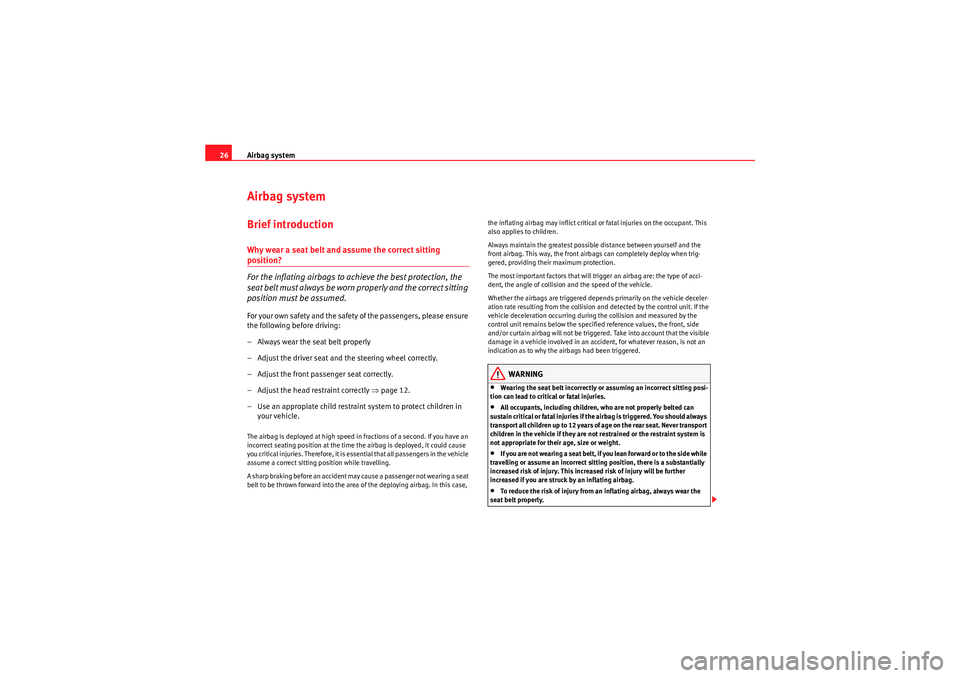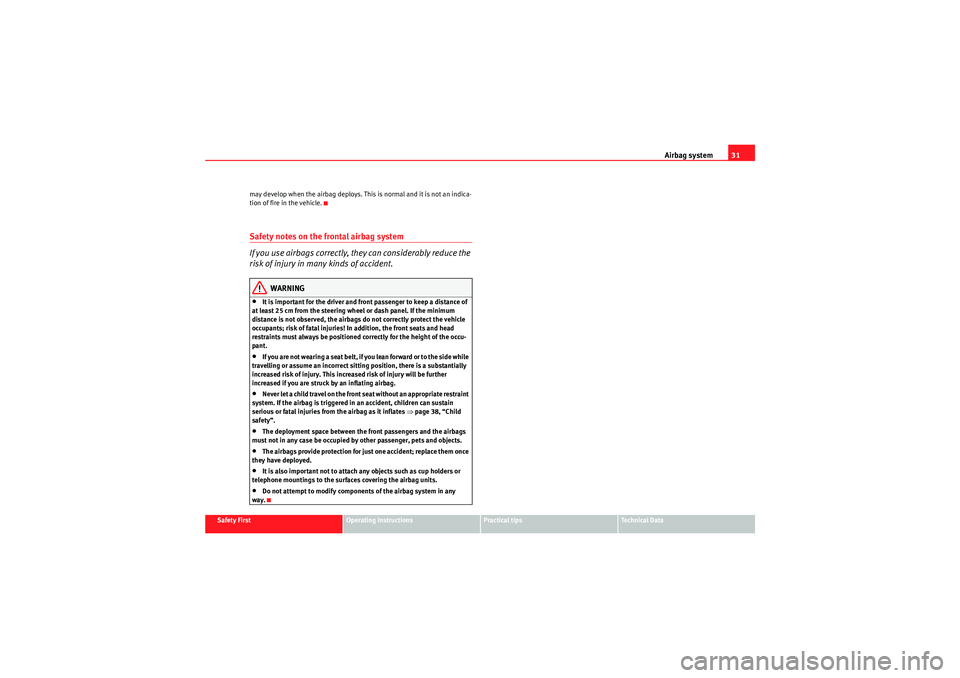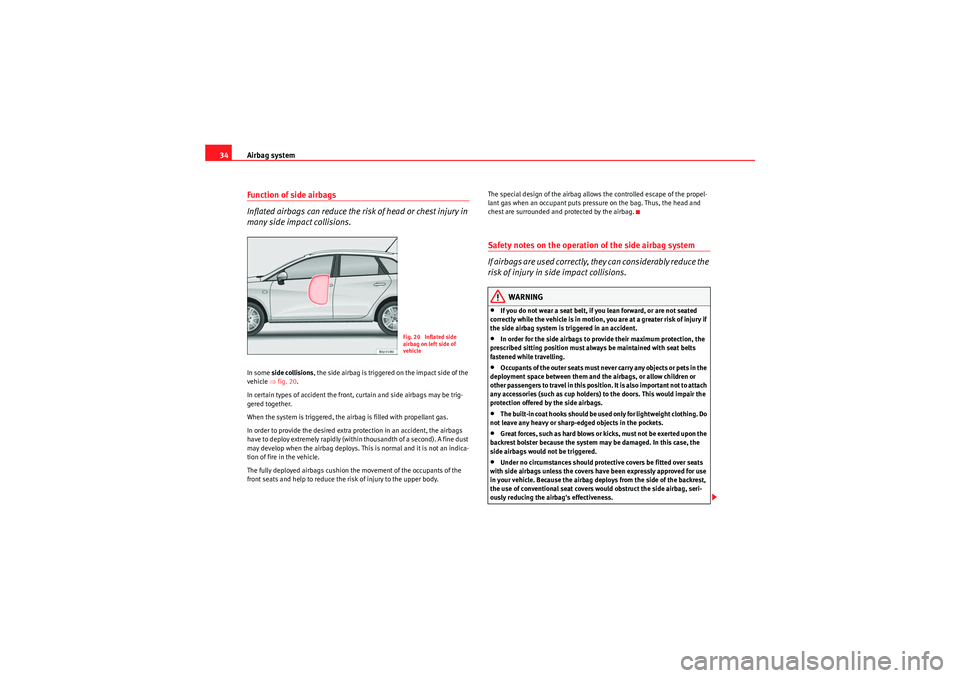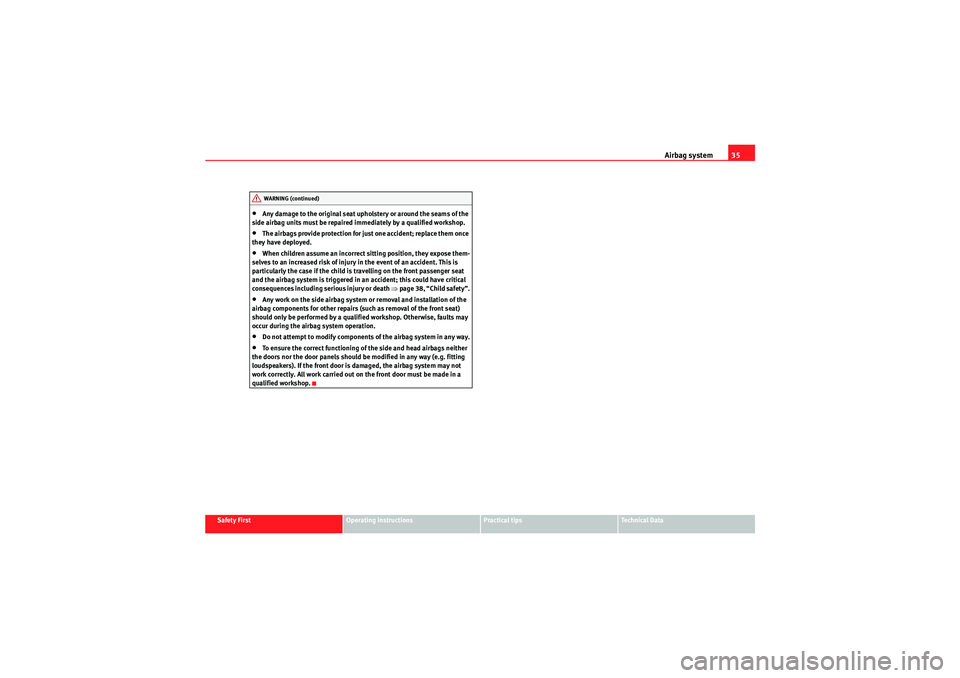2009 Seat Ibiza ST child seat
[x] Cancel search: child seatPage 24 of 250

Seat belts23
Safety First
Operating instructions
Practical tips
Technical Data
WARNING
•An incorrectly worn seat seat belt can cause severe injuries in the event
of an accident.•The shoulder belt must be positioned around the middle of the
shoulder. The seat belt must lie flat and snugly on the torso ⇒page 22,
fig. 12 .•The lap part of the seat belt must lie across the pelvis, never across the
stomach. The seat belt must lie flat and snugly on the pelvis ⇒page 22,
fig. 13 . Pull the belt tight if necessary to take up any slack.•Read and observe the warnings ⇒page 20.
Pregnant women must also fasten their seat belts properly
The best protection for the unbo rn child is for the mother to
wear the seat belt properly at all times during the pregnancy.
The seat belt provides maximum protection only when the seat belt
is properly positioned ⇒page 22.
– Adjust the front seat and head restraint correctly.
– Holding the latch plate, pull the belt evenly across your chest and as low as possible over the pelvis ⇒fig. 14 .
– Insert the latch plate into the buckle for the corresponding seat and push it down until it is securely locked with an audible click
⇒ .
– Pull the belt to ensure that the latch plate is securely engaged in the buckle.
WARNING
•An incorrectly worn seat seat belt can cause severe injuries in the event
of an accident.•For pregnant women, the lap part of the seat belt must lie as low as
possible over the pelvis, never across the stomach, and always lie flat so
that no pressure is exerted on the abdomen.•Read and observe the warnings ⇒page 20.
Fig. 14 Positioning seat
belts during pregnancy
Ibiza ST_EN.book Seite 23 Dienstag, 12. Januar 2010 4:03 16
Page 25 of 250

Seat belts
24Seat belt release
The seat belt must not be unfastened until the vehicle has
come to a standstill.– Press the red button on the belt buckle ⇒fig. 15 . The latch plate
is released and springs out ⇒.
– Guide the belt back by hand so that it rolls up easily and the trim is not damaged
WARNING
Never unbuckle a seat belt while the vehicle is in motion. If you do, you
increase the risk of sustaining severe or fatal injuries.
Incorrectly fastened seat belts
Incorrectly worn seat belts can cause severe or even mortal
injuries.Seat belts can provide optimal protection only if the belt web is
properly worn. The seat belts must be fastened exactly in the order
described in this chapter. An in correct sitting position impairs
substantially the protection a seat belt offers and can lead to severe
or fatal injuries. The risk of severe or fatal injuries is especially
increased when a deploying airbag strikes an occupant who has
assumed an incorrect sitting position. As the driver, you are respon-
sible for all vehicle occupants, especially children. Therefore:
– Never allow anyone to wear the seat belt incorrectly while the vehicle is moving ⇒.
WARNING
•An incorrectly worn seat belt increases the risk of severe injuries.•Before every trip, instruct your passengers to adjust their seat belts
properly and to wear them for the whole journey.•Read and always observe information and warnings concerning the use
of seat belts ⇒page 20.
Fig. 15 Removing latch
plate from buckle
Ibiza ST_EN.book Seite 24 Dienstag, 12. Januar 2010 4:03 16
Page 27 of 250

Airbag system
26Airbag systemBrief introductionWhy wear a seat belt and assume the correct sitting position?
For the inflating airbags to achieve the best protection, the
seat belt must always be worn properly and the correct sitting
position must be assumed.For your own safety and the safety of the passengers, please ensure
the following before driving:
– Always wear the seat belt properly
– Adjust the driver seat and the steering wheel correctly.
– Adjust the front passenger seat correctly.
– Adjust the head restraint correctly ⇒page 12.
– Use an appropiate child restraint system to protect children in your vehicle.The airbag is deployed at high speed in fractions of a second. If you have an
incorrect seating position at the time the airbag is deployed, it could cause
you critical injuries. Therefore, it is essential that all passengers in the vehicle
assume a correct sitting position while travelling.
A sharp braking before an accident may cause a passenger not wearing a seat
belt to be thrown forward into the area of the deploying airbag. In this case, the inflating airbag may inflict critical or fatal injuries on the occupant. This
also applies to children.
Always maintain the greatest possible distance between yourself and the
front airbag. This way, the front airbags can completely deploy when trig-
gered, providing their maximum protection.
The most important factors that will trigger an airbag are: the type of acci-
dent, the angle of collision and the speed of the vehicle.
Whether the airbags are triggered depends primarily on the vehicle deceler-
ation rate resulting from the collision and detected by the control unit. If the
vehicle deceleration occurring during the collision and measured by the
control unit remains below the specified reference values, the front, side
and/or curtain airbag will not be triggered. Take into account that the visible
damage in a vehicle involved in an accident, for whatever reason, is not an
indication as to why the airbags had been triggered.
WARNING
•Wearing the seat belt incorrectly or assuming an incorrect sitting posi-
tion can lead to critical or fatal injuries.•All occupants, including children, who are not properly belted can
sustain cr it ical or fatal inju ries if t he airbag is triggered. You s hould al ways
transport all children up to 12 years of age on the rear seat. Never transport
children in the vehicle if they are not restrained or the restraint system is
not appropriate for their age, size or weight.•I f yo u are n o t w ea r i ng a s ea t b e l t , i f yo u l e an fo r w a rd o r t o t h e s id e w h il e
travelling or assume an incorrect sitting position, there is a substantially
increased risk of injury. This increased risk of injury will be further
increased if you are struck by an inflating airbag.•To reduce the risk of injury from an inflating airbag, always wear the
seat belt properly.
Ibiza ST_EN.book Seite 26 Dienstag, 12. Januar 2010 4:03 16
Page 28 of 250

Airbag system27
Safety First
Operating instructions
Practical tips
Technical Data
•Always properly adjust the front seats.
The danger of fitting a child seat on the front passenger seat
Rear-facing child seats must never be used on the front
passenger seat when the front passenger airbag is enabled.An enabled front airbag on the front passenger side is potentially a major
danger to a child. The front passenger seat is life threatening to a child if
he/she is transported in a rear-facing child seat. You should always transport
all children up to 12 years of age on the rear seat.
If a rear-facing child seat is secured to the front passenger seat, an inflating
airbag can strike it with such great force that critical or fatal injuries may
result.
Therefore we strongly recommend you to transport children on the rear seats.
That is the safest place for children in the vehicle. Alternatively, the front
passenger airbag can be disabled with a key-operated switch ⇒page 36.
When transporting children, use a child seat appropriate to the age and size
of each child.
For those vehicles that do not include a key lock switch to turn the airbag off,
an Authorised Service Centre must be consulted.
WARNING
•If a child seat is secured to the front passenger seat, the risk to the child
of sustaining critical or fatal injuries in the event of an accident increases.•Never secure a rear-facing child seat to the front passenger seat if the
front passenger airbag is enabled. The child can suffer critical or fatal inju-
ries when the front passenger airbag is triggered.
•An inflating front passenger airbag can strike the rear-facing child seat
and hurl it with great force against the door, the roof or the backrest.•If, under special circumstances, it is necessary to transport a child in a
rear-facing child seat on the front passenger seat, it is absolutely essential
that you observe the following safety measures:
−Disable the front passenger airbag ⇒page 36, “Deactivating
airbags*”.
− The child seat must be approved by the child seat manufacturer for
use on a front passenger seat with front or side airbag.
− Follow the installation instructions of the child seat manufacturer
and absolutely observe all warnings
− Before properly installing the child seat, push the front passenger
seat completely backwards so that the greatest possible distance to
the front passenger airbag is ensured.
− Ensure that no objects prevent the front passenger seat from being
pushed completely back.
− The backrest of the front passenger seat must be in an upright
position.
Warning lamp for airbag and belt tension device system
This warning lamp monitors the airbag and belt tensioner
system.The warning lamp monitors all airbags and belt tensioners in the vehicle,
including control units and wiring connections.
WARNING (continued)
WARNING (continued)
Ibiza ST_EN.book Seite 27 Dienstag, 12. Januar 2010 4:03 16
Page 32 of 250

Airbag system31
Safety First
Operating instructions
Practical tips
Technical Data
may develop when the airbag deploys. This is normal and it is not an indica-
tion of fire in the vehicle.
Safety notes on the frontal airbag system
If you use airbags correctly, they can considerably reduce the
risk of injury in many kinds of accident.
WARNING
•It is important for the driver and front passenger to keep a distance of
at least 25 cm from the steering wh eel or dash panel. If the minimum
distance is not observed, the airbags do not correctly protect the vehicle
occupants; risk of fatal injuries! In addition, the front seats and head
restraints must always be positioned correctly for the height of the occu-
pant.•If you are not wearing a seat belt, if you lean forward or to the side while
travelling or assume an incorrect sitting position, there is a substantially
increased risk of injury. This increased risk of injury will be further
increased if you are struck by an inflating airbag.•Never let a child travel on the front seat without an appropriate restraint
system. If the airbag is triggered in an accident, children can sustain
serious or fatal injuries from the airbag as it inflates ⇒page 38, “Child
safety”.•The deployment space between the front passengers and the airbags
must not in any case be occupied by other passenger, pets and objects.•The airbags provide protection for just one accident; replace them once
they have deployed.•It is also important not to attach any objects such as cup holders or
telephone mountings to the surfaces covering the airbag units.•Do not attempt to modify components of the airbag system in any
way.
Ibiza ST_EN.book Seite 31 Dienstag, 12. Januar 2010 4:03 16
Page 35 of 250

Airbag system
34Function of side airbags
Inflated airbags can reduce the risk of head or chest injury in
many side impact collisions.In some side collisions , the side airbag is triggered on the impact side of the
vehicle ⇒fig. 20 .
In certain types of accident the front, curtain and side airbags may be trig-
gered together.
When the system is triggered, the airbag is filled with propellant gas.
In order to provide the desired extra protection in an accident, the airbags
have to deploy extremely rapidly (within thousandth of a second). A fine dust
may develop when the airbag deploys. This is normal and it is not an indica-
tion of fire in the vehicle.
The fully deployed airbags cushion the movement of the occupants of the
front seats and help to reduce the risk of injury to the upper body. The special design of the airbag allows the controlled escape of the propel-
lant gas when an occupant puts pressure on the bag. Thus, the head and
chest are surrounded and protected by the airbag.
Safety notes on the operation of the side airbag system
If airbags are used correctly, they can considerably reduce the
risk of injury in side impact collisions.
WARNING
•If you do not wear a seat belt, if you lean forward, or are not seated
correctly while the vehicle is in motion, you are at a greater risk of injury if
the side airbag system is triggered in an accident.•In order for the side airbags to provide their maximum protection, the
prescribed sitting position must always be maintained with seat belts
fastened while travelling.•Occupants of the outer seats must never carry any objects or pets in the
deployment space between them and the airbags, or allow children or
other passengers to travel in this position. It is also important not to attach
any accessories (such as cup holders) to the doors. This would impair the
protection offered by the side airbags.•The built-in coat hooks should be us ed only for lightweight clothing. Do
not leave any heavy or sharp-edged objects in the pockets.•Great forces, such as hard blows or kicks, must not be exerted upon the
backrest bolster because the system may be damaged. In this case, the
side airbags would not be triggered.•Under no circumstances should protective covers be fitted over seats
with side airbags unless the covers have been expressly approved for use
in your vehicle. Because the airbag deploys from the side of the backrest,
the use of conventional seat covers would obstruct the side airbag, seri-
ously reducing the airbag's effectiveness.
Fig. 20 Inflated side
airbag on left side of
vehicle
Ibiza ST_EN.book Seite 34 Dienstag, 12. Januar 2010 4:03 16
Page 36 of 250

Airbag system35
Safety First
Operating instructions
Practical tips
Technical Data
•Any damage to the original seat upholstery or around the seams of the
side airbag units must be repaired immediately by a qualified workshop.•The airbags provide protection for just one accident; replace them once
they have deployed.•When children assume an incorrect sitting position, they expose them-
selves to an increased risk of injury in the event of an accident. This is
particularly the case if the child is travelling on the front passenger seat
and the airbag system is triggered in an accident; this could have critical
consequences including serious injury or death ⇒page 38, “Child safety”.•Any work on the side airbag system or removal and installation of the
airbag components for other repairs (such as removal of the front seat)
should only be performed by a qualified workshop. Otherwise, faults may
occur during the airbag system operation.•Do not attempt to modify components of the airbag system in any way.•To ensure the correct functioning of the side and head airbags neither
the doors nor the door panels should be modified in any way (e.g. fitting
loudspeakers). If the front door is damaged, the airbag system may not
work correctly. All work carried out on the front door must be made in a
qualified workshop.WARNING (continued)
Ibiza ST_EN.book Seite 35 Dienstag, 12. Januar 2010 4:03 16
Page 37 of 250

Airbag system
36Deactivating airbags*Disabling front passenger airbag
If you fit a rear-facing child seat to the front passenger seat,
the front passenger airbag must be de-activated.
When the passenger airbag is deactivated, this means that only the
passenger front airbag is deactiva ted. All the other airbags in the
vehicle remain functional.
Disabling front passenger airbag
– Switch the ignition off.
– Turn the ignition switch in the key operated switch in the glove
compartment to the position OFF ⇒ fig. 21 .
– Check that the warning lamp “AIRBAG OFF” on the dash panel ⇒fig. 22 remains lit ⇒ when the ignition is switched on.
Enabling front passenger airbag
– Switch the ignition off.
– Turn the ignition key in the ke y-operated switch in the glove
compartment to the position ON ⇒ fig. 21 .
Fig. 21 In the glove
compartment: key for
enabling and disabling
front passenger airbag
Fig. 22 Warning lamp for
deactivated passenger
airbag in centre console
Ibiza ST_EN.book Seite 36 Dienstag, 12. Januar 2010 4:03 16